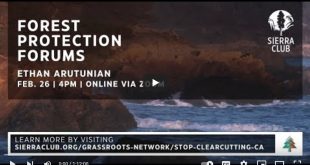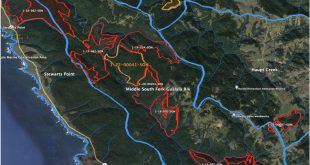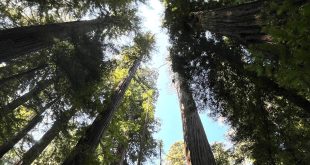1-08NTMP-009 MEN
This non-industrial timber management plan (NTMP) was approved by the California Department of Forestry and Fire Protection (CAL FIRE) on December 31, 2009, despite widespread concern over plans to log the last remaining stand of old growth redwoods in the Doty Creek planning watershed.
The Center for Biological Diversity, Friends of the Gualala River, and Coast Action Group have petitioned the Mendocino County Superior Court to over-turn the approval of the logging plan because it violates California environmental laws.
More information:
Press Release
Legal Petition
Comment letters on Bower NTMP
Over 200 members of the public
CAL FIRE is required to respond to Lawsuit filed by |
Plan documents
Plan summary
The Bower logging plan (1-08NTMP-009 MEN) includes approximately 615 acres located north and northeast of the town of Gualala, CA.
[click to enlarge]
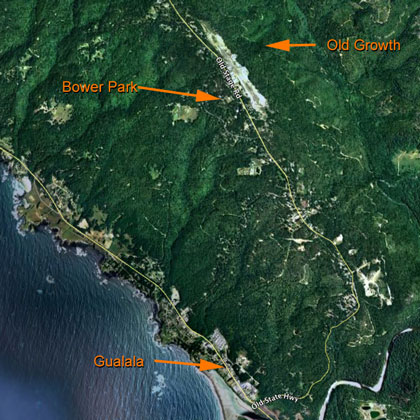
Bower NTMP logging plan, Gualala, CA
A non-industrial timber management plan (NTMP) is a long-term logging plan with no expiration date. Once an NTMP is approved, the landowner can cut trees without further environmental review, by filing a simple Notice of Timber Operations.
The main issues identified by Fish & Game and Water Quality staff during review of 1-08NTMP-009 MEN relate to cutting a stand of old growth redwoods (in Unit 9) and proposed flood-plain logging (in Units 10 & 11).
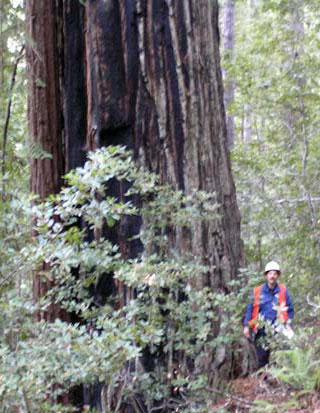
Old growth redwood above Little North Fork Gualala River
in Unit 9 of the Bower NTMP logging plan
photo: Department of Fish & Game
Old Growth logging
Fish & Game (DFG) staff recommended retaining (not cutting down) a stand of remnant old growth redwoods in Unit 9 – located east of the Gualala airport, on steep slopes heading down to the Little North Fork Gualala River. Their concern centered on the importance of old growth (“late seral”) forest as wildlife habitat.
This stand, with trees estimated to be at least 120 to 450 years old, is the last known stand of late-seral habitat in the Doty Creek planning watershed.
 northern spotted owl |
The stand provides irreplaceable wildlife habitat, with suitable nesting and roosting sites for northern spotted owl (right) and marbled murrelet (below), both of which are listed as threatened under the federal Endangered Species Act.
 marbled murrelet |
The plan will retain a few of the wildlife trees in the late-successional forest stand (LSFS) designated by DFG, but will cut down most of the irreplaceable old growth, which would have a significant adverse impact on wildlife habitat.
To protect this critically important habitat, CAL FIRE should require that the plan be revised to retain the wildlife trees in Unit 9 as recommended by the Department of Fish & Game.
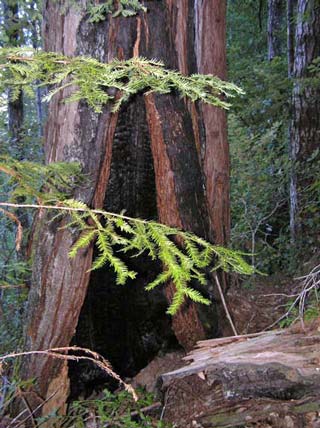
Old growth redwood with fire-derived basal hollow
in Unit 9 of the Bower NTMP logging plan
photo: Department of Fish & Game
Information on marbled murrelet
Marbled murrelets, federally listed as a threatened species, have been detected within the NTMP Biological Assessment Area (within two minutes, as the murrelet flies).
Unit 9 of the NTMP contains irreplaceable old growth which provides suitable nesting habitat for these threatened seabirds. Cutting down these trees and destroying essential habitat for these birds would cause irreparable and unmitigatable harm.
The US Fish and Wildife Service is the foremost federal authority on recovery of marbled murrelet and has presented the best available science in many documents including:
- Recovery Plan for the threatened marbled murrelet (Brachyramphus marmoratus) in Washington, Oregon and California, US Fish & Wildlife Service, 1997.
- Final 2009 5-Year Status Review for the Marbled Murrelet, US Fish & Wildlife Service, 2009.
Recovery efforts in the past have often focused on large contiguous areas of late-successional forest, but recent studies have documented the importance of small blocks of late seral habitat as essential to bridging the gap between northern and southern murrelet populations.
- Individual Legacy Trees Influence Vertebrate Wildlife Diversity in Commercial Forests, US Forest Service, 2004.
- Ecology and conservation of the marbled murrelet, US Forest Service, 1995.
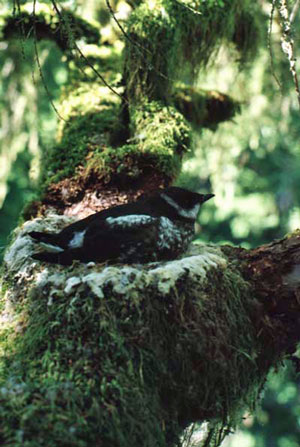
Marbled murrelet nesting in old growth tree
photo: US Department of Fish & Wildlife
Floodplain logging
Water Quality and Fish & Game staff objected to the proposed flood-plain logging in the Bower NTMP (Units 10 & 11, adjacent to the confluence of the North Fork and Little North Fork Gualala River), based on potential harm to endangered coho salmon and threatened steelhead trout.
Several proposed flood-plain logging plans in this area of the North Fork Gualala River were denied (Cassidy THP) or abandoned (Lily THP) after the National Marine Fisheries Service (NMFS) stated that the plans would harm coho salmon and steelhead trout, which are listed as endangered and threatened (respectively) under the federal Endangered Species Act.
In response to agency recommendations, the Bower NTMP plan has been amended to eliminate the proposed flood-plain logging.
 Friends of Gualala River Protecting the Gualala River watershed and the species living within it
Friends of Gualala River Protecting the Gualala River watershed and the species living within it


